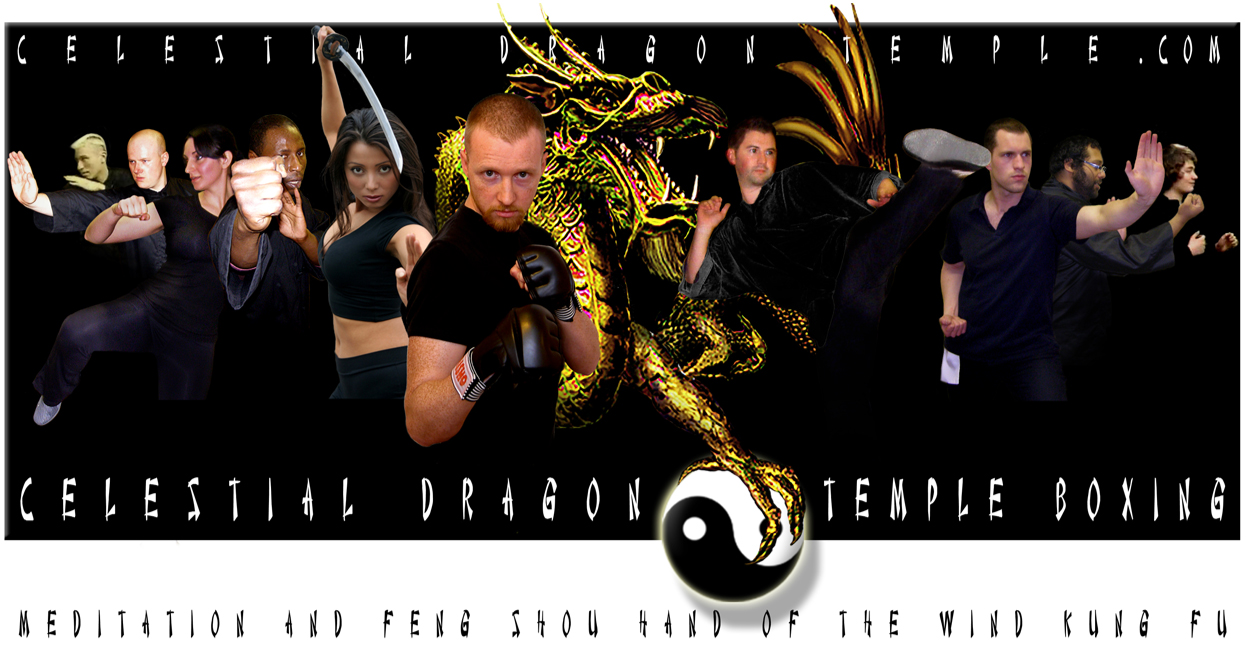
Celestial Dragon Temple Boxing
"Valour, Honour, Compassion, Justice"
Celestial Dragon Temple Boxing 天龍寺拳 (also known as TianLong Temple Boxing or Heavenly Dragon Temple Boxing) is a style of kung fu, founded in the United Kingdom by Feng Shou 3rd Tengchi Neil Brown.
Students of this martial arts organisation are dedicated to the study and practice of two kung fu styles:
1. Celestial Dragon Temple Boxing.
2. Feng Shou Hand of the Wind kung fu.
Both styles combine spiritual principle, meditation, mind training and energy work with martial arts/self defence practice.
The Celestial Dragon Temple Boxing syllabus was submitted as a new style of kung fu to the Executive Committee of The Amateur Martial Association in March 2010, where it was assessed, officially recognised and accepted as a new and valid style of martial art.
Spiritual Philosophy
In Chinese dragon mythology, the Celestial Dragon (Chinese: 天龍
pinyin: tiānlóng; Wade-
Celestial Dragon Temple Boxing students are encouraged to embrace spiritual development by embarking (or continuing) on a Path of Enlightenment as the foundation of their study and practice, focusing primarily, but not exclusively, on the tenets of Taoism and Buddhism, interwoven with aspects of the Western Wisdom Tradition. This approach is not intended as a replacement for religious beliefs the student may already hold.
Martial Influences
Celestial Dragon Temple Boxing’s primary martial influences are
Lee style Feng Shou (Hand of the Wind), a Taoist art of kung fu over 2000 years old,
and Jun Fan Jeet Kune Do (Bruce Lee’s Way of the Intercepting Fist), an approach
to kung fu established by Bruce Lee and officially recognised in the 20th century.
Years of blending the primary underlying principles and techniques of Feng Shou and Jeet Kune Do, through practice, application, exploration and reflection, naturally resulted in a new viewpoint. The essence of this has crystalised in the form of Celestial Dragon Temple Boxing.
The martial concept of ‘firing an arrow and touching fire’ – ie, striking fast and
withdrawing the hand, foot or even the whole body with equal speed – is integral
to the art, as is the utilisation of the straight line, curves, spiralling techniques,
evasions and ward-
This is summarised in the following description of the art’s Celestial Dragon stance, attained by students when they reach 1st Degree black sash:
Celestial Dragon Stance
Like the shifting form of a dragon manifesting in clouds or
water, Celestial Dragon stance represents fluidity of posture. Previously conditioned
by form (stability gained by the numerous stances learnt, understood and mastered
throughout the course of training), the student is now in a position to free himself
– to ‘break the mould’ – and is able to continuously adjust his posture in subtle
ways to best suit the needs of the moment. Like a dragon in the clouds, he cannot
be pinned down to one shape. Just when you think you see him, he changes before your
eyes to something you may not even recognise, yet still he is present in the invisible
wind, the shadows of bamboo, the swaying of strong-
(extract from The Art of Celestial Dragon Temple Boxing, by Neil Brown, © 2010)